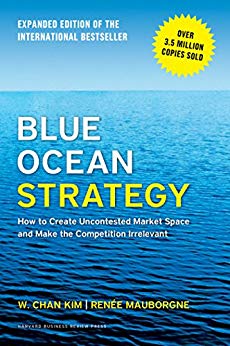

This article is an excerpt from the Shortform summary of "Blue Ocean Strategy" by W. Chan Kim and Renee Mauborgne. Shortform has the world's best summaries of books you should be reading.
Like this article? Sign up for a free trial here .
What is Blue Ocean Strategy? Learn the definition of blue ocean strategy and the meaning of creating blue oceans here.
Much of business strategy in the past few decades has focused on competition, including Michael Porter’s five forces and SWOT analysis. In these red oceans, market structures are known, and companies try to outperform rivals to grab share of existing demand. Over time, markets become crowded, products become commodities competing on price, and profits dissipate. This trend is aggravated by technological improvements that allow incredible creation of supply that can outstrip demand, causing further price competition.
In contrast, blue ocean strategy creates new market spaces, creates new demand, and leads to profitable growth. Here, the market structure is yet to be decided, so the price competition is far less intense. In other words, the definition of a blue ocean strategy is creating a new, uncontested market space where the existing competition is irrelevant.
Properties of Blue Oceans
Blue oceans are being continuously created. A century ago, these industries didn’t exist: automobiles, aviation, health care, music recording. 40 years ago, these industries didn’t exist: e-commerce, mobile phones, personal computers, biotechnology, coffee shops. It’s certain that 10-30 years from now, new unknown industries will be created.
To focus on red-ocean competition is to deny the dynamism of changing markets, and to miss out on massive opportunities.
Blue ocean strategies lead to more profitable growth. The authors studied business launches of 108 companies. They found that 86% of launches were incremental extensions of existing markets, but they accounted for 62% of revenues and 39% of profits. In contrast, 14% of launches created blue oceans, and they generated 38% of total revenues and 61% of profits.
(Shortform note: This analysis doesn’t consider the likelihood of success of a red vs blue ocean strategy, i.e. blue oceans may be higher-risk higher-reward).
Blue ocean strategy doesn’t seek to trade off value with cost. In classical business strategy, companies can compete either by creating higher-value products at higher cost, or undercut competitors at lower cost. Blue ocean strategy seeks to do both simultaneously. It raises buyer value by creating elements the industry never previously offered. It also reduces cost by eliminating unnecessary factors the industry competes on. (This is fairly abstract and becomes clear with the Cirque du Soleil example below.)
There is no permanently successful executor of blue ocean strategy. All industries rise and fall. All companies rise and fall. Blue ocean strategy can be executed by both startups and incumbents.
Technology innovation is not necessary for blue ocean strategy. It is sometimes present, but more often the innovation was creating something new that buyers value.
Red Ocean vs Blue Ocean
Here’s a simple summary of how a traditional red ocean strategy matches up to a blue ocean strategy:
| Red ocean strategy | Blue ocean strategy |
| Compete in existing industry. | Create a new uncontested industry. |
| Beat the competition. | Avoid competition and make competitors irrelevant. |
| Fight for existing demand. | Create new demand. |
| Trade off value for cost. | Simultaneously increase value and decrease cost. |
| Winning is zero-sum against competitors. | Winning is non-zero-sum. |
| Market structure is fixed, and you play within the structure. | The market can be restructured. |
| Follow best practices and improve on them. | Break the best practice rules. |
How to Find New Blue Ocean Strategies
Now that we understand what blue oceans are, the rest of the book discusses how to create a blue ocean strategy and how to execute it. Chapters 3-6 are about developing and planning the strategy. Chapters 7-10 are about executing the strategy.
The first step to creating blue ocean strategy is to find new ideas and redefine markets as they’re commonly understood. The book offers 6 paths to find new blue ocean opportunities outside your immediate industry.
Path 1: Look at Your Customer’s Alternatives
Don’t tunnel vision on competing in your current industry – consider alternatives that customers have for your product. What other products or services do customers use to achieve the same goal? How can you use these in your blue ocean strategy?
For instance, cinemas and restaurants have superficially different forms, but they serve the same purpose of having a night out.
Examples
- In travel, businesses tend to either own their own jet (less travel time but expensive and sitting idle much of the time) or book business-class commercial flights (more travel time but cheaper).
- NetJets sells fractions of jets (as small as 1/16th ownership at $400,000), trying to get the best of both alternatives. It eliminates the hassle of commercial airlines while avoiding the overhead of total jet ownership, while also offering the convenience of regional airports, direct flights, and customized in-flight service.
- In the 1990s, telecom in Japan consisted of cell phones (not yet connected to the internet) and the internet accessible through desktop computers.
- NTT DoCoMo decided to bring the killer apps of the internet (email, news, entertainment) to cell phones through i-mode, eliminating the complexity of accessing the broad internet for the less powerful mobile phones. The i-mode phone was 25% more expensive than a regular cell phone but much cheaper than a PC or laptop. This phone served as the gateway to the internet for a generation of Japanese users and was the first smartphone to be mass-adopted by a country.
- Southwest looked to driving as their model for transportation convenience and price, rather than look at other airlines.
Key questions: What alternatives do customers have to your product? Why do they use them? Focus on the key factors that lead customers to alternatives, and eliminate everything else.
Path 2: Look at Different Strategic Groups in Your Industry
Strategic groups comprise companies within an industry that pursue a similar strategy. Generally, strategic groups differ on two dimensions: price and performance. Luxury car brands like BMW and Mercedes form one group; budget car brands like Hyundai and Honda form another. Typically, different strategic groups don’t pay much attention to each other.
As with alternative industries above, consider why customers trade up and down between strategic groups, and concentrate on delivering those factors while eliminating needless ones. This can be your blue ocean strategy definition.
Examples:
- Female fitness had two large groups – traditional gyms and home exercise programs. Gyms were higher-end, offering a full range of equipment, instructors, a pool and sauna, etc. for $100+ a month. While gyms had useful social elements, going there could be intimidating for women and had unnecessary features. On the other end, home exercise programs (like workout videos) were below $100 for a one-time purchase, but they often failed to instill motivation.
- Curves offered a new group workout class tailored to women. It preserved the social factor while eliminating unnecessary features like saunas, thus reducing cost to $30 per month. Classes featured easy-to-use machines arranged in a circle to promote group interaction. Franchising became far cheaper than opening a new gym, allowing an explosion across the country.
- Ralph Lauren created a brand of “high fashion with no fashion,” combining the luxury of materials and store design of high fashion with the classical look of Brooks Brothers.
- Lexus offered the quality of Mercedes and BMW at lower prices comparable to Lincoln.
Key questions: Why do customers trade up or down in your industry for price and performance? Can you combine the best factors into a new offering, while eliminating everything else?
Path 3: Consider Different Buyers in the Chain
Companies often target the person with purchasing power, who may sometimes be a different person with different preferences from the actual user. For instance, a corporate software vendor often caters to the CTO (who cares about cost reduction) rather than the engineers who will use the product (who care about ease of use).
Consider targeting the end-user’s pain points, especially if they’ve traditionally been ignored, and creating a new product with a different value curve. You can create a blue ocean strategy by appealing to underserved users or customers.
———End of Preview———

Like what you just read? Read the rest of the world's best summary of "Blue Ocean Strategy" at Shortform . Learn the book's critical concepts in 20 minutes or less .
Here's what you'll find in our full Blue Ocean Strategy summary :
- What blue oceans are, and how you create one for your business
- Why some businesses succeed in creating blue oceans, and why others fail
- The red ocean traps you have to avoid if you want business growth






